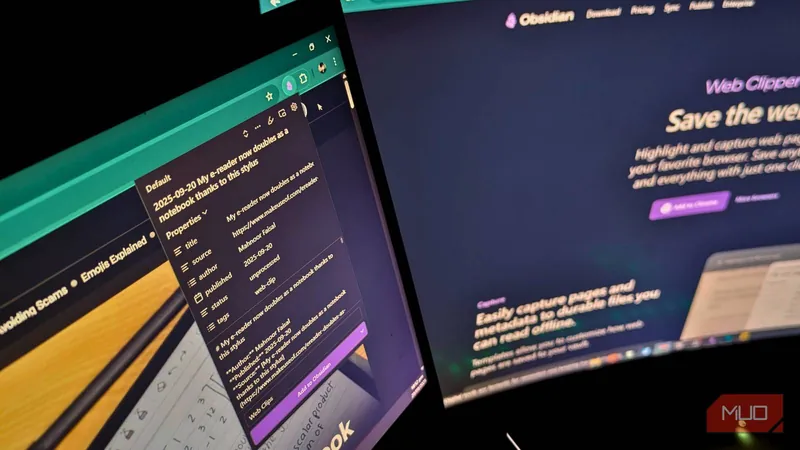
Transform Your Online Reading into a Powerful Knowledge Library!
2025-09-23
Author: Benjamin
Are you tired of losing valuable insights from your endless hours of online reading? Like many knowledge workers, I found myself drowning in a sea of articles and blog posts, only to forget them when they could have been useful. My bookmarks became nothing more than a digital graveyard—until I discovered a revolutionary solution!
Enter Obsidian's Web Clipper! This tool has completely transformed my reading and research process. Rather than saving links that could break or become obsolete, I capture the full text and context of each article, empowering me to build a growing library of knowledge that I can actually use.
Why Traditional Bookmarking Falls Short
Most people treat online content as disposable. You read it, maybe bookmark it, and move on. But real knowledge compounds when you connect ideas, and that’s impossible when everything is trapped in forgotten folders. I often found myself revisiting the same articles, frustratingly unable to uncover the key insights I once found so compelling.
Another major drawback of traditional bookmarking is reliability. Websites disappear, URLs change, and some content becomes inaccessible due to paywalls. I can’t count how many times I’ve clicked on a bookmark only to be greeted by an error page.
Revolutionizing My Workflow with Web Clipper
With the Web Clipper, every article I save becomes part of a cohesive library. The powerful search function enables me to rediscover content and link new ideas effortlessly. I can annotate and evolve my clipped articles over time, leading to a rich, interconnected foundation of knowledge.
Setting Up Your Obsidian Web Clipper Library
Getting started is both simple and effective. First, install the Obsidian Web Clipper extension from your browser. Then, create a folder within your Obsidian vault, naming it something like ‘Web Clips.’
Next, configure the settings within the Web Clipper, ensuring that it matches the exact name of your vault. This precision is key to ensuring nothing goes awry.
Optimizing Your Clipper with Templates
Templates dictate how your web content appears in Obsidian. While the default option is functional, it's not tailored for research. I customized mine to include a naming format that helps me track content chronologically.
I also embed essential metadata, such as the source URL, author, publication date, and tags, allowing for seamless organization and retrieval.
The Quick Clipping Process
Once configured, clipping articles takes just seconds. A click on the Web Clipper icon scans the page, fills in all the necessary fields, and with one more click, the article is saved in Obsidian—formatted beautifully and complete with all my specified properties.
Harnessing the Power of Obsidian Search
Obsidian’s search and tagging capability are game changers. After reading an article, I mark its status as 'processed,' making it easy to locate unread pieces later. The search function works across all saved text, letting me find articles by keywords, themes, or even vague recollections.
I also utilize tags to link related clips together. This not only organizes my library but also allows me to pull specific insights on related topics whenever needed.
From Chaos to Clarity
The Web Clipper has fundamentally changed my approach to online reading. No longer am I losing exceptional articles in a sea of bookmarks; instead, I’ve forged a knowledge base that strengthens with each addition. My casual browsing now actively informs my professional work, ensuring I can always find exactly what I need, precisely when I need it.









 Brasil (PT)
Brasil (PT)
 Canada (EN)
Canada (EN)
 Chile (ES)
Chile (ES)
 Česko (CS)
Česko (CS)
 대한민국 (KO)
대한민국 (KO)
 España (ES)
España (ES)
 France (FR)
France (FR)
 Hong Kong (EN)
Hong Kong (EN)
 Italia (IT)
Italia (IT)
 日本 (JA)
日本 (JA)
 Magyarország (HU)
Magyarország (HU)
 Norge (NO)
Norge (NO)
 Polska (PL)
Polska (PL)
 Schweiz (DE)
Schweiz (DE)
 Singapore (EN)
Singapore (EN)
 Sverige (SV)
Sverige (SV)
 Suomi (FI)
Suomi (FI)
 Türkiye (TR)
Türkiye (TR)
 الإمارات العربية المتحدة (AR)
الإمارات العربية المتحدة (AR)